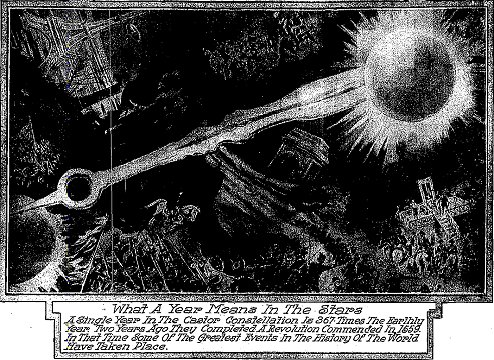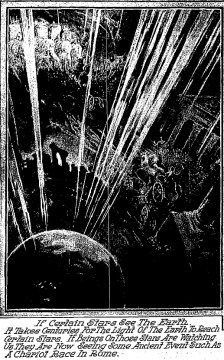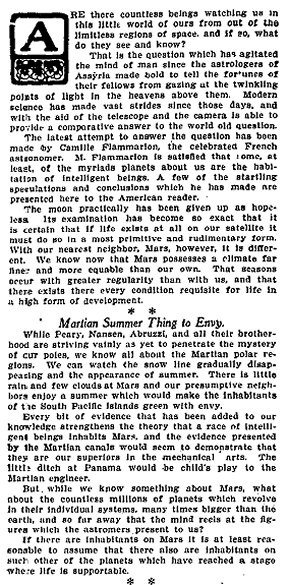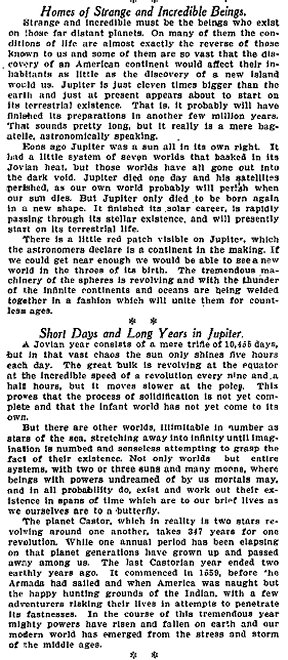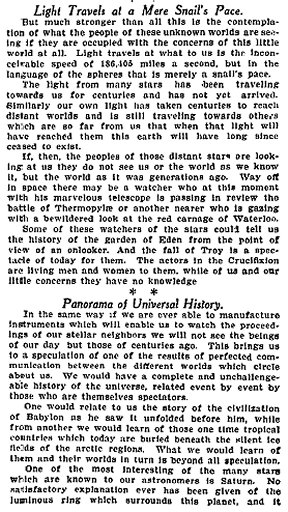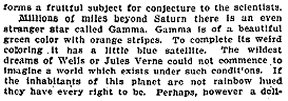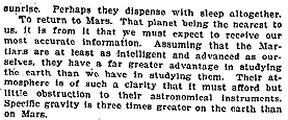Are there countless beings watching us in this little
world of ours from out of the limitless regions of space, and if so, what
do they see and know?
That is the question which has agitated the mind of man
since the astrologers of Assyria made bold to tell the fortunes of their
fellows from gazing at the twinking points of light in the heavens above
them. Modern science has made vast strides since those days, and with the
aid of the telescope and the camera is able to provide a comporative answer
to the world old question.
The latest attempt to answer the question has been made
by Camille Flammarion,
the celebrated French astronomer (see the www.erbzine.com/dan)
M. Flammarion is satisfied that some, at least, of the myriad planets about
us are the habitation of intelligent beings. A few of the startling speculations
and conclusions which he has made are presented here to the American reader.
The moon practically has been given up as hopeless. Its
examination has become so exact that it is certain that if life exists
at all on our satellite it must do so in a most primitive and rudimentary
form. with our nearest neighbor, Mars, however, it is different. We know
now that Mars possesses a climate far finer and more equable than our own.
That seasons occur with greater regularity than with us, and that there
exists there every condition requisite for life in a high form of development.
MARTIAN SUMMER THING TO ENVY
While Peary, Mansen, Abruzzi, and all their brotherhood
are striving vainly as yet to penetrate the mystery of our poles, we know
all about the Martian polar regions. We can watch the snow line gradually
disappearing and the appearance of summer. There is little rain and few
clouds at Mars and our presumptive neighbors enjoy a summer which would
make the inhabitants of the South Pacific islands green with envy.
Every bit of evidence that has been added to our knowledge
strengthens the theory that a race of intelligent beings inhabits Mars,
and the evidence presented by the Martian canals would seem to demonstrate
that they are our superiors in the mechanical arts. The little ditch at
Panama would be child's play to the Martian engineer.
But, while we know something about Mars, what about the
countless millions of planets which revolve in their individual systems,
many times bigger than the earth, and so far away that the mind reels at
the figures which the astronomers present to us?
If there are inhabitants on Mars it is at least reasonable
to assume that there also are inhabitants on such other of the planets
which have reached a stage where life is supportable.
HOMES OF STRANGE AND INCREDIBLE BEINGS
Strange and incredible must be the beings who exist on
those far distant planets. On may of them the conditions of life are almost
exactly the reverse of those known to us and some of them are so vast that
the discovery of an American continent would affect their inhabitants as
little as the discovery of a new island would us. Jupiter is just eleven
times bigger than the earth and just at present appears about to start
on its terrestrial existence. That is, it probably will have finished its
preparations in another few million years. That sounds pretty long, but
it really is a mere bagatelle, astronomically speaking.
Eons ago Jupiter was a sun all in its own right. It had
a little system of seven worlds that basked in its Jovian heat, but those
worlds have all gone out into the dark void. Jupiter died one day and his
satellites perished, as our own world probably will perish when our sun
dies. But Jupiter only died to be born again in a new shape. It finished
its solar career, is rapidly passing through its stellar existence, and
will presently start on its terrestrial life.
There is a little red patch visible on Jupiter, which
the astronomers declare is a continent in the making. If we could get near
enough we would be able to see a new world in the throes of its birth.
The tremendous machinery of the spheres is revolving and with the thunder
of the infinite continents and oceans are being welded together in a fashion
which will unite them for countless ages.
SHORT DAYS AND LONG YEARS IN JUPITER
A Jovian year consists of a mere trifle of 10,4** days,
but in that vast chaos the sun only shines five hours each day. The great
bulk is revolving at the equator at the incredible speed of a revolution
every nine and a half hours, but it moves slower at the poles. This proves
that the process of solidification is not yet complete and that the infant
world has not yet come into its own.
But there are other worlds, illimitable in number as stars
of the sea, stretching away into infinity until imagination is numbed and
senseless attempting to grasp the fact of their existence. Not only worlds
bu entire systems, with two or three suns and many moons, where beings
with powers undreamed of by us mortals may, and in all possibility do,
exist and work out their existence in spans of time which are to our brief
lives as we ourselves are to a butterfly.
The planet Castor, which in reality is two stars revolving
around one another, takes 347 years for one revolution. While one annual
period has been elapsing on that planet generations have grown up and passed
away among us. The last Castorian year ended two earthly years ago. It
commenced in 1659, before the Armada had sailed and when America was naught
bu the happy hunting grounds of the Indian, with a few adventurers risking
their lives in attempts to penetrate its fastnesses. In the course of this
tremendous year might powers have risen and fallen on earth and our modern
world has emerged from the stress and storm of the middle ages.
LIGHT TRAVELS AT A MERE SNAIL'S PACE
But much stronger than all this is the contemplation
of what the people of these unknown worlds are seeing if they are occupied
with the concerns of this little world of all. Light travels at what to
us is the inconceivable speed of 185,106 miles a second, but in the language
of the spheres that is merely a snail's pace.
The light from many stars has been traveling towards us
for centuries and has not yet arrived. Similarly our own light has taken
centuries to reach distant worlds and is still traveling towards others
which are so far from us that when that light will have reached them this
earth will have long since ceased to exist.
I, then, the peoples of those distant stars are looking
at us they do not see us or the world as we know it, but the world as it
was generations ago. Way off in space there may be a watcher who at this
moment with his marvelous telescope is passing in review the battle of
Thermopylm or another nearer who is gazing with bewildered look at the
red carnage of Waterloo.
Some of these watchers of the stars could tell us the
history of the garden of Eden from the point of view of an onlooker. And
the fall of Troy is a spectacle of today for them. The actors in the Crucifixion
and living men an d women to them, while of us and our little concerns
they have no knowledge.
PANORAMA OF UNIVERSAL
HISTORY
In the same way if we are ever able to manufacture instruments
which will enable us to watch the proceedings of our stellar neighbors
we will not see the beings of our day but those of centuries ago. This
brings us to a speculation of one of the results of perfected communication
between the different worlds which circle about us. We would have a complete
and unchallengeable history of the universe, related event by event by
those who are themselves spectators.
One would relate to us the story of the civilization of
Babylon as he saw it unfolded before him, while from another we would learn
of those one time tropical countries which today are hurled beneath the
silent ice fields of the arctic regions. What we would learn of them and
their worlds in turn is beyond all speculation.
One of the most interesting of the many stars which are
known to our astronomers is Saturn. No satisfactory explanation ever has
been given of the luminous ring which surrounds this planet, and it forms
a fruitful subject for conjecture to the scientists.
Millions of miles beyond Saturn there is an even stranger
star called Gamma. Gamma is of a beautiful green color with orange stripes.
To complete its weird coloring it has a little blue satellite. The wildest
dreams of Wells or Jules Verne could not commence to imagine a world which
exists under such conditions. If the inhabitants of this planet are not
rainbow hued they have every right to be. Perhaps, however, a delicate
pea-green may prove more in harmony with their surroundings. As for the
vegetation and fauna, what is the use of trying to conceive flowers which
grow in a green and orange world with a blue moon smiling down on them
at night!
Away off in Sirius old mother earth looks like a little
bit of a star. That is if our light has yet reached there, which is improbable.
Sirius started sending its rays down to us before Eve had tempted Father
Adam to eat that apple and commenced all our troubles for us. The sirens
may have gone to live in Sirius when they got snubbed by Ulysses.
A few trillions of miles away there is a small and discrete
star called Alpha. It is just 250,000 times as far from us as the sun,
but that does not bother Alpha in any way because it has two suns all of
its own and so is in no danger of freezing to death. Alpha's two suns sometimes
reign together and sometimes alternate, a combination which must prove
trying when the inhabitants go to bed at sunset and find that it is really
sunrise. Perhaps they dispense with sleep altogether.
To return to Mars. That planet being the nearest to us.
It is from it that we must expect to receive our most accurate information.
Assuming that the Martians are at least as intelligent and advanced as
ourselves, they have a far greater advantage in studying the earth than
we have to studying them. Their atmosphere is of such a clarity that it
must afford but little obstruction to their astronomical instruments. Specific
gravity is three times greater on the earth than on Mars.


